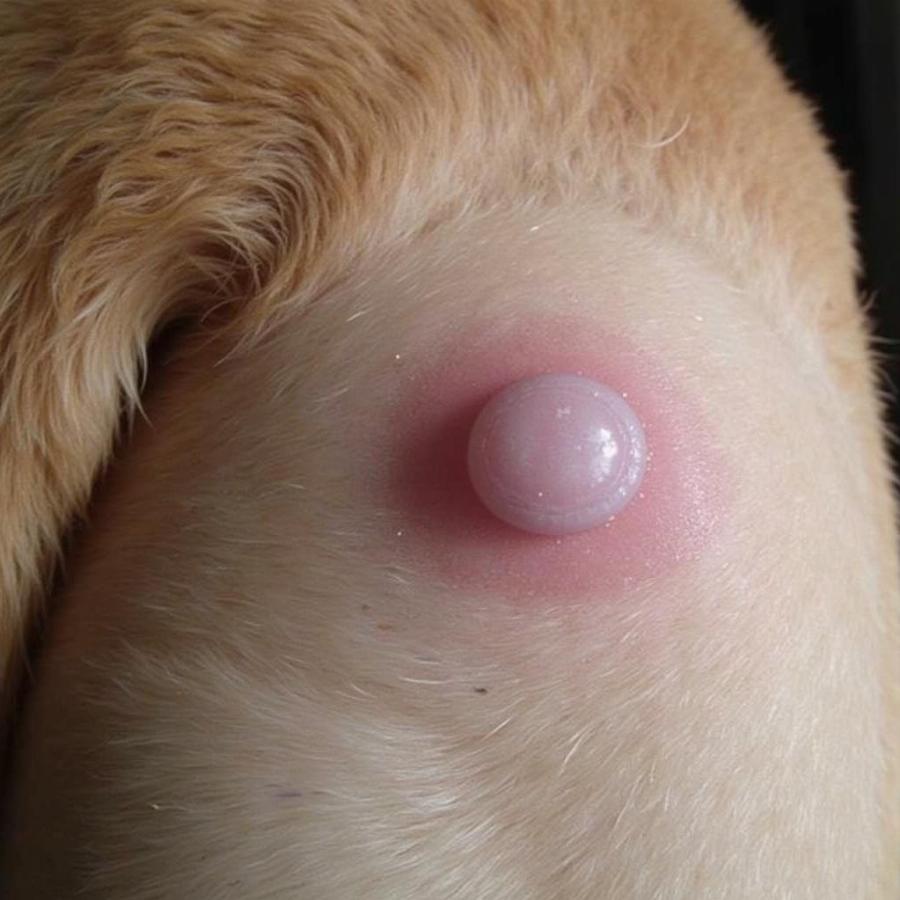Finding a lump on your beloved dog’s rib cage can be alarming. It’s natural to worry, but it’s important to remember that not all lumps are cancerous. Many are benign, meaning they are not harmful. However, it’s crucial to consult with your veterinarian to determine the cause and best course of action. This article will explore common reasons for lumps on a dog’s rib cage, when to be concerned, and steps you can take to ensure your furry friend receives the best possible care.
Common Causes of Lumps on a Dog’s Rib Cage
There are several reasons your dog might develop a lump on their rib cage. Some of the most common include:
- Benign tumors: These are non-cancerous growths that are often harmless. Common types include lipomas (fatty tumors), mast cell tumors, and histiocytomas.
- Abscesses: These are painful, pus-filled lumps that can form due to an infection or bite wound.
- Skin tags: These are small, benign growths that protrude from the skin. They are more common in older dogs and certain breeds.
- Insect bites or stings: These can cause localized swelling that may feel like a lump.
- Enlarged lymph nodes: Lymph nodes are small, bean-shaped organs that are part of the immune system. They can become enlarged due to infection, inflammation, or cancer.
When to Be Concerned About a Lump on Your Dog’s Ribs
While many lumps are benign, it’s crucial to contact your veterinarian if you notice any of the following:
- Rapid growth: A lump that grows quickly or changes size significantly in a short period.
- Pain or discomfort: If your dog seems bothered by the lump or cries out when it’s touched.
- Ulceration or bleeding: A lump that breaks open, bleeds, or oozes discharge.
- Firmness or immobility: A lump that feels hard, fixed in place, and doesn’t move easily under the skin.
- Changes in your dog’s behavior: Loss of appetite, lethargy, or other unusual behaviors.
 Dog with a Lump on Rib Cage
Dog with a Lump on Rib Cage
Diagnosing a Lump on a Dog’s Rib Cage
Your veterinarian will perform a physical exam and ask about your dog’s medical history. To determine the cause of the lump, they may recommend one or more of the following diagnostic tests:
- Fine-needle aspiration (FNA): A small needle is inserted into the lump to collect cells for microscopic examination.
- Biopsy: A small tissue sample is removed and analyzed to determine the type of growth.
- Blood tests: These can help assess your dog’s overall health and rule out certain conditions.
- X-rays or ultrasound: These imaging tests can provide a clearer picture of the lump and surrounding tissues.
Treatment Options for Lumps on Dogs
The treatment for a lump on your dog’s rib cage will depend on the underlying cause. Options may include:
- Monitoring: For benign lumps that are not causing any problems, your veterinarian may recommend simply monitoring the growth over time.
- Medication: Antibiotics may be prescribed for abscesses or infections. Anti-inflammatory medication can help reduce swelling and discomfort.
- Surgery: Surgical removal is often recommended for cancerous tumors, some benign tumors, and abscesses.
Early Detection is Key
Regularly checking your dog for lumps and bumps is an essential part of responsible pet ownership. By getting in the habit of petting your dog all over, you’ll become familiar with their normal body contours and be more likely to notice any unusual changes.
“Early detection is crucial when it comes to treating lumps and bumps in dogs,” says Dr. Emily Carter, a veterinarian with over 15 years of experience. “The sooner we can diagnose and address the problem, the better the outcome for your furry friend.”
Conclusion
Discovering a lump on your dog’s rib cage can be a worrisome experience. Remember that many lumps are benign and treatable. By scheduling a prompt appointment with your veterinarian, you’re taking the best possible step to ensure your beloved companion receives the appropriate care and attention they deserve.
FAQs about Lumps on a Dog’s Rib Cage
Q: Are lumps on dogs always cancerous?
A: No, not all lumps on dogs are cancerous. Many are benign, meaning they are not harmful. However, it’s important to consult with your veterinarian to determine the cause and best course of action.
Q: What should I do if I find a new lump on my dog?
A: If you find a new lump on your dog, it’s essential to schedule an appointment with your veterinarian as soon as possible. They can examine the lump, determine its cause, and recommend the appropriate treatment.
Q: Can lumps on dogs go away on their own?
A: Some lumps, such as those caused by insect bites or minor inflammation, may resolve on their own. However, it’s crucial to have any new or changing lumps evaluated by your veterinarian to rule out more serious conditions.
Q: Is it painful for my dog to have a lump removed?
A: Your veterinarian will use pain management techniques to ensure your dog is comfortable during and after any procedures, including lump removal surgery.
Q: How can I prevent my dog from getting lumps?
A: While not all lumps are preventable, maintaining your dog’s overall health through regular veterinary checkups, a balanced diet, exercise, and parasite prevention can help reduce their risk of developing certain types of lumps.
Interested in learning more about dog health and well-being? Check out these related articles:
- [Link to an article about common dog skin conditions]
- [Link to an article about caring for senior dogs]
Beaut Dogs is your trusted source for all things related to dog care. We are passionate about providing dog owners with the information and resources they need to keep their furry companions happy and healthy. For personalized advice and support, contact us at [email protected]. We’re here to help!